Fleet Minesweeper

Battle Honours
PACIFIC 1941 - 1945
NEW GUINEA 1942 - 44
OKINAWA 1945
Specifications
Bathurst-class corvette
Builder: Broken Hill Pty Ltd, Whyalla South Australia
Displacement: 733 tons
Length: 186 ft
Beam: 31 ft
Draught: 8 ft 6 in
Propulsion: triple expansion engine, 2 shafts. 2,000 hp
Speed: 15 Knots
Armament: 1 12 Ponder, later1 × QF 4 inch Mk XIX gun, 3 × Oerlikon 20 mm cannons (later 4), 1 × Bofors 40 mm gun (installed later), 2 x.303 Vickers machine guns, 40 Depth charges (4 throwers and 2 chutes)
Crew complement: 85
Commanding Officers
Lt. Cdr. Charles F
Mills, RAN 10 Oct 1942
Lt. David Simpson Thomson, RANR(S)
06 Dec 1943
Cdr. Alan Jeger
Travis, RAN Jan 1945
Lt. Colin Kenneth Mackenzie, RANVR 23 Jun 1945
Related items
None
Reminiscences
None
Gallery
None
H.M.A.S. PIRIE
Read aloud
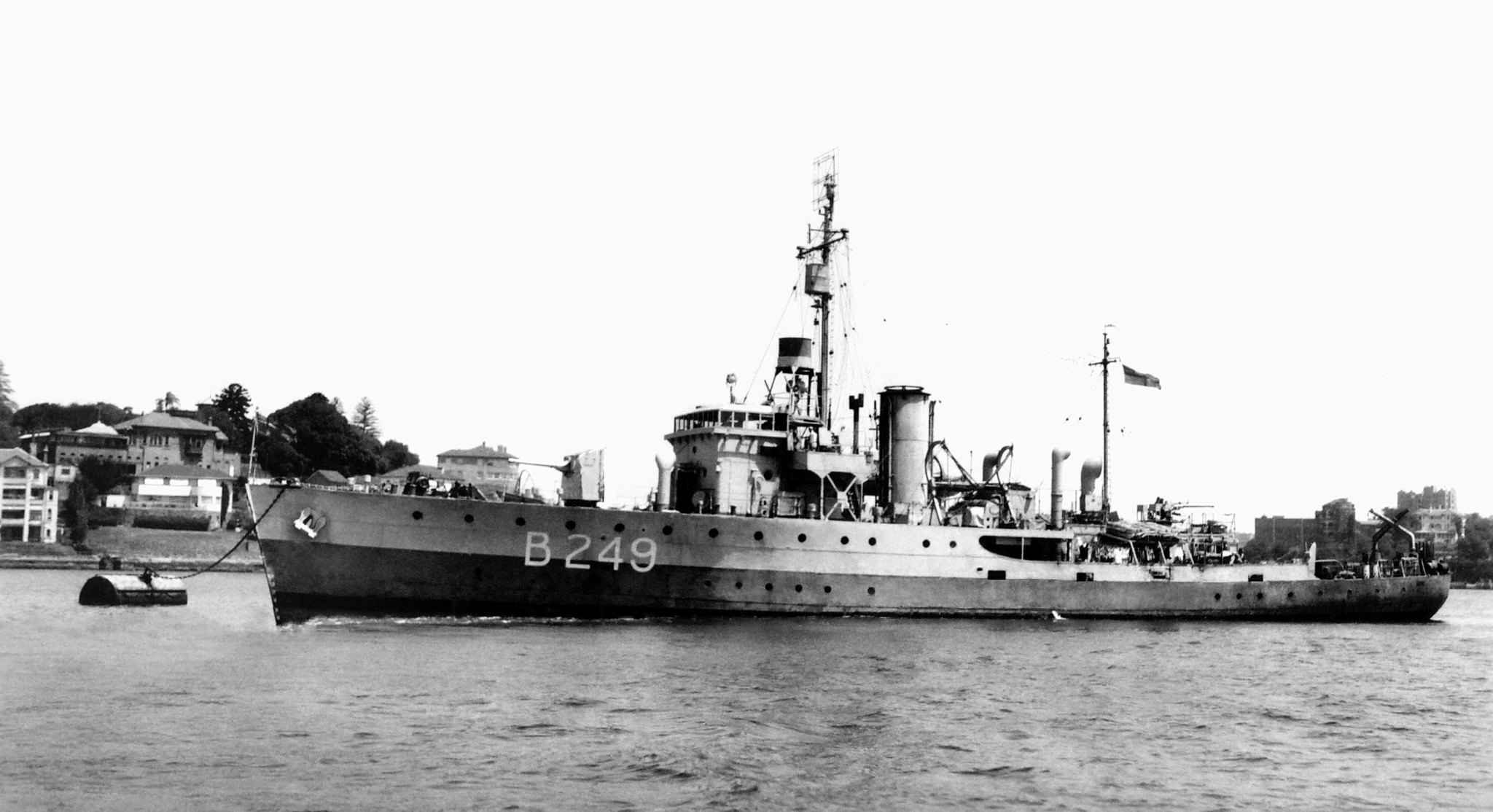
Early history
A Bathurst class Minesweeper ordered from the Broken Hill Pty Ltd, Whyalla South Australia, on April 16th 1940. Her keel was laid down on May 19th 1941 and she was launched December 3rd 1941 by her sponsor, Mrs Kleeman, wife of Whyalla Superintendent, Broken Hill Pty Ltd. She was commissioned into the Royal Australian Navy as HMAS PIRIE at 11:30 on Saturday October 10th 1942, Lieutenant Commander Charles Ferry Mills RAN in command.
HMAS PIRIE was to remain at Whyalla until Monday October 12th during which time shipyard employees worked onboard late into the night completing unfinished work, with stores and gear from the shipyard being received throughout this time. PIRIE received her ammunition on the afternoon of October 11th. At 07:08 the following morning she departed for Port Adelaide via Port Pirie after shich she was named.
Departing Port Adelaide at 09:00 on November 7th, PIRIE sailed direct to Melbourne, arriving in Port Phillip Bay at 07:20 on Monday the 9th; she then proceeded to Williamstown berthing at the outer east dockyard pier at 10:55. For the next 7 days work was carried out to complete her fitting out, including the fitting of Gyro Compass, repeaters, the minesweeping kite wires were fitted as was ‘A’ guns spray shield. Gunnery and minesweeping trials were carried out in Port Phillip Bay on Tuesday 17th. The following day PIRIE commenced a two week working-up period completing on December 4th when she was ordered to proceed independently to Sydney, arriving on the 7th, she entered Sydney Harbour at 05:28 securing to No.5 buoy Watson’s Bay.
On December 27th 1942, PIRIE put to sea at 06:00 to begin duty as a convey escort, initially screening coastal convoys on the east coast based out of Townsville, Queensland. Between convoy escorts she conducted A/S (anti-submarine) patrols. Her first convoy was the 3 merchant vessels of TN.21 departing Townsville on January 3rd and arriving at Fall River on the 6th. In March she sailed as part of convoy TN.57 to Port Moresby, Papua New Guinea this comprised of 4 warships, PIRIE, her sister ship KAPUNDA, Destroyer ARUNTA and ML 1161, departing Townsville on the 20th and arriving at Port Moresby on the 23rd.
Attacked on Convoy escort duties
PIRIE sailed from Milne Bay on April 10th as escort for HMS HANYANG bound for Oro Bay , part of operation Lilliput. At 12:05 on the 11th PIRIE learned that enemy aircraft were in the vicinity of Oro Bay. By 12:20 both PIRIE and HANYANG were closed up at action stations. Fifteen minutes later enemy aircraft, D3A Val dive bombers escorted by A6M Zeros, were over the convoy and proceeded to attack.
The Japanese bombers concentrating their attack on HANYANG, with PIRIE at a distance of five cables and zig zagging, and giving AA fire. Two direct hits were scored on the HANYANG and two near misses, killing one and wounding six others. The Japanese next turned their attention to PIRIE with six near misses and one direct hit which struck the centre of the bullet-proof canopy over the bridge and penetrated the canopy, struck and instantly killed the Gunnery Officer, passed out through the fore side of the bridge carrying away the starboard soft-iron sphere and the De-Gaussing correction coil, before landing on the upper deck at the foot of the amidships ventilator and there exploding, killing six members of the twelve pounder gun’s crew and seriously wounding the gun layer. They then proceeded to strafe PIRIE with cannon fire wounding a further four Ratings including the unfortunate lookout in the crow’s nest. The strafing attack had caused considerable damage to PIRIE’s aerials and had completely shot away all but one of the signal halyards and the forecastle deck was all but destroyed. The bomb blast penetrated the deck and set fire to the kit lockers in the forecastle mess, while a cannon shell had cut through a steam pipe and filled the mess with steam. The raid was over by 12:50 when the enemy were driven off by allied fighter aircraft.
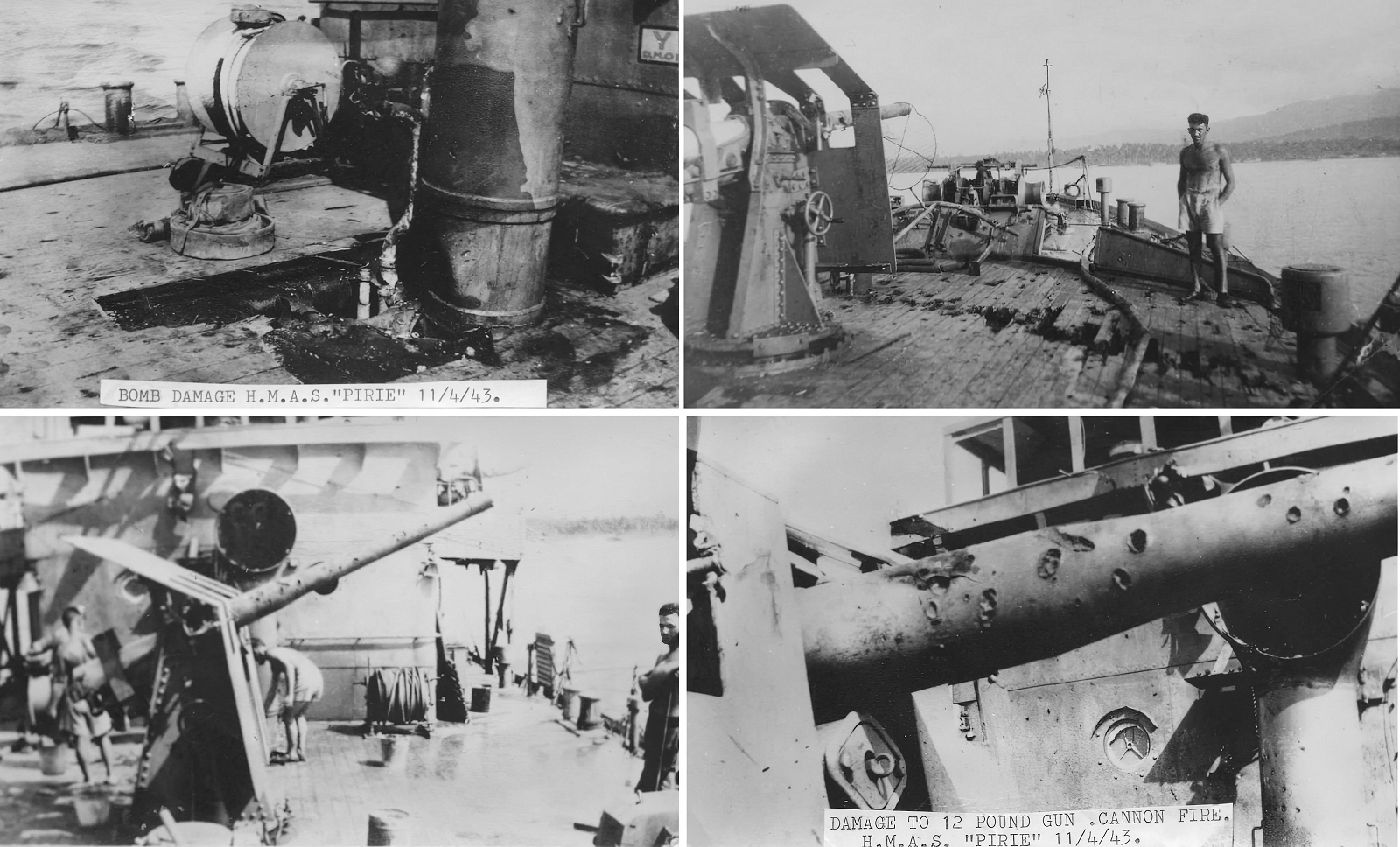
Images showing the bomb and cannon fire damage to HMAS PIRIE’s fore deck and 12 Ponder gun.
Badly damaged PIRIE was ordered to return to Milne Bay and eventually to return to Townsville, leaving Milne Bay escorted by HMAS Swan at 04:10 on April 14th; she was to proceed to Walkers Limited, Maryborough to refit.
The refit commenced on Tuesday April 20th and Walkers Limited had completed the refit by May 17Tth, ad PIRIE being ordered to sail to Evans Deaken Shipyards, Brisbane where the remaining work would be completed. Her repairs completed, PIRIE returned to service on May 28th, sailing with HMAS ECHUCA as escorts for convoy P.G.52A to Sydney, departing Brisbane at 04:00 and secured at Kurraba Point Wharf in Sydney Harbour at 17:45 on the 30th. She returned to Townsville worth convoy B.V.65, arriving there on June 7th.
Mutiny
By the time the ship had arrived back on station at Townsville the crew were unhappy with the captain’s strict rules, especially those regarding the ‘rig of the day’ and which uniform could be worn on a run ashore. Lt. Cdr Mills, unlike other corvette captains who allowed their crew to go ashore in a variety of uniforms, insisted that his men wear their best dress ‘Number 1’s’.The unrest amongst the ‘Hostilities only’ ratings appears to have been further inflamed upon PIRIE’s entry into Townsville Harbour when the pipes “Hands fall in, in rig of the day” and “Down all washed clothes” was made; HMAS BOWEN was shifting berth to go alongside WAGGA at the time, the contrast could not have been more obvious - clothes were strung all over the ship with a wash line strung from the funnel to the fresh water tank containing washed clothes and all along ‘X’ deck ,and the crew on the Quarterdeck were wearing only shorts.
At 082:0 on the morning of Wednesday June 9th 1 Lt. Cdr Mills received a report from his Executive Officer Lieutenant R. A. Lorains RANR(S) that the pipe “Hands fall in” at 08:15 had not been obeyed and that the Ship’s Company were congregated on the mess deck and that certain hands had not obeyed his personal order to fall in. Lt. Cdr Mills ordered “Hands fall in” to be piped again immediately, but this also was disobeyed. The acting Coxswain proceeded to the mess deck to find out what grievances were alleged by the crew and he returned ten minutes later with a list of nine complaints. The captain called for a ‘clear lower deck’ but none of the Ordinary or Able Stamen attended. At 17:20 the Naval Officer-in-Charge, Townsville accompanied by an armed guard boarded PIRIE. He ordered the pipe “Clear lower deck – everybody aft” to be piped, this time the pipe was obeyed. Articles 10 and 11 of the articles of war were read, with the Naval Officer-in-Charge ordering PIRIE to sea calling on any men who were unwilling to sail the ship to stand aside. No Rating stood aside and the hands were warned that the ship would sail at 20:23 for Cid Harbour, Whitsunday Islands.
A Board of Inquiry following the so-called ‘mutiny’ was conducted from 11:00 on Thursday June 10Th until 16:00 on Friday June 11th. The resulting punishments were handed out at t 08:05 on Tuesday June 15th when punishment warrants were read before the ship’s company at a ‘clear lower deck’ - nine of these were for imprisonment, with the offenders departing PIRIE immediately, several other crewmen received drafts to other ships.
Following the Board of Inquiry and the ship purged of the undesirable ratings PIRIE spent the next six months escorting between Australia and New Guinea. PIRIE began her second refit at Garden Island Dockyard, Sydney from Saturday November 13th until Sunday December 5th 1943 with the crew on long leave. Lieutenant David Simpson Thomson, RANR(S), assumed command during the refit. During the refit she received a new 4” Q.F. Mk. XIX gun and new A.272 and A.286P Radar units. On completion of her post refit work-up she returned to convoy escort duties between Townsville and New Guiana beginning with convoy TN.197 which sailed from Townsville on December 24th, arriving at Milne Bay on the 28th. On March 10th 1944 PIRIE was transferred to the Darwin Station escorting between Thursday Island and Darwin. She escorted her next convoy TD.50 from Thursday Island on April 5th.
Minesweeping duties August – September 1944
In mid-July she was allocated to operate in the minesweeping role in company with sister corvette HMAS KALGOORLIE (senior officer) and sailed on July19th to conduct a day of sweeping exercises and to calibrate their Orepesa Sweep gear. Returning to harbour on completion of the exercises another accompanying vessel, M.L. 805, was in difficulty, having fouled her screws whilst exercising the mine-recovery net. PIRIE transferred a six-inch hawser to M.L. 805, then proceeded to tow her back to harbour, both vessels arriving at 18:55. The next day KALGOORLIE (senior officer and PIRIE sailed from Thursday Island at 06:30 en-route to Endeavour Strait via Flinders Passage, anchoring off Red Wallis Island at 09:55. They were to conduct ‘Operation KILNICK, the clearance of defensive minefields that had been laid in the through the Great Barrier Reef and in the various passages from just south of Cairns to the New Guinea coast by HMAS BUNGAREE in 1942 and 1943.
Very few, if any, of the crew from either corvette had, had practical experience in the art of minesweeping, until now they had been employed on A/S patrol and convoy escort duties This was dangerous work in an area with few accurate navigation charters. On July 23rd two mines detonated in KALGOORLIE’s sweep near Thursday Island, only 22 metres astern the explosions covered the ship in water and some damage was caused to electrical equipment and a broken pipe in the engine room along with some loosened r rivets. Her sweeping gear was badly damaged. PIRIE had a close call with a mine in August 1944 when the lack of accurate navigation references had her inadvertently transiting the COASTER minefield; a leading stoker throwing his slops over the side spotted a Mk XIV mine nestling alongside PIRIE’s port side.
PIRIE and KALGOORLIE participated in 5 stages of Operation KILNICK and by the time they were release from the operation on September 28th a total of four hundred and fifteen mines were removed and destroyed without mishap. The two corvettes now parted company; PIRIE’s proceeded to Cairns with KALGOORLIE went to Townsville. ON arrival at Cairns on September 30th PIRIE commenced a 7 day boiler clean and self-maintenance period before being docked in the American Floating Dock ARD 7 to have remedial work and new equipment installed. While high and dry an inspection was made to establish what underwater damage had been sustained by a grounding on a reef on September 13tth. A number of longitudinal scratches were noticed on either side of the keel and the blades of both screws were damaged; the port propeller had two blades slightly bent at the tips, and one blade had a piece broken off approximately eight square inches in all. The starboard propeller had one blade bent, with a radial split two inches long from the lip to the base of the bend. She was undocked on the 9th.
Under refit & allocated for service with the East Indies Fleet, November 1944
PIRIE returned to Thursday Island in Mid-October to complete operations before arriving at Brisbane on November 5th to begin a refit which was to last until December 7th r with the Ship’s Company on long leave. Satisfactory post refit trials were conducted in Moreton Bay on the 8th.
PIRIE now had orders to proceed to Trincomalee, Ceylon to join the British East Indies Fleet via Melbourne and Fremantle. Live firing exercises were carried in Moreton Bay on December 14th, shooting at a towed drogue for AA practice and a towed target for low angle firing; on completion of the drills PIRIE continued on out to sea en-route to Melbourne. While on passage on the 15th off Port Macquarie a strong sonar contact was acquired at 13:55 and classified as a submarine; the ship carried out three attacks runs, a total of fifteen depth charges were fired but the attack was discontinued when it was realised that the target was the wreck of the WOLLONGBAR which had not been incorrectly marked on the charts. She arrived at Melbourne at 16:18 on Monday December 18th. She sailed for Fremantle at 12:26 the next day, calling at Swan Island anchorage to replenish her depth charges.
She arrived at Fremantle at 18:07 on December 26th 1944; she was scheduled to continue her passage to Ceylon but was ordered to remain at Fremantle and await orders. A new commanding officer arrived on Wednesday December 27th, acting Commander Alan Jeger Travis, RAN relieving Lieutenant Thomson, RANR(S).
Allocated to the 22nd Minesweeping Flotilla and the Brutish Pacific Fleet
With the war now focused on the Japanese in the Pacific PIRIE was to join the new 22nd Minesweeping Flotilla along with HMA Ships CAIRNS, CESSNOCK, GAWLER, GERALDTON, IPSWICH, LAUNCESTON, TAMWORTH, and WOLLONGONG, for service with the British Pacific Fleet (BPF). The Flotilla was formed at Trincomalee and arrived at Fremantle on February 9th 1945.
During January PIRIE conducted training in gunnery and anti-Submarine detection, the later on exercises with American submarines BASHAW, FLASHER and PAMPANITO, concluding with minesweeping exercises on the 29th in company with sister corvettes LAUNCESTON and WARRNAMBOOL. On Wednesday January 31st PIRIE in company with LAUNCESTON departed Fremantle at 0600 bound for Sydney.
On arrival at Sydney Harbour on Friday February 9th PIRIE and LAUNCESTON were placed under the administrative control of Captain Escort Forces, British Pacific Fleet and attached temporarily to the 21st Minesweeping Flotilla. Her pennant number, J189 usually painted on her sides below the forward gun, was now changed to B249 and repainted for operations in the Pacific All ships of the BPF and its logistic support organisation, the Fleet Train, were under American command for operations in the Pacific and were required to adopt the American signalling procedure, every vessel receiving a new pennant number.
On February 24th PIRIE in company with the corvettes BENDIGO, GOULBURN, (towing a Patt VI target) LISMORE LAUNCESTON, and MARYBOROUGH put to sea to carry out low angle/ high angle close range firings. On completion of the live firing exercises at 11:45 BENDIGO, GOULBURN, LISMORE and MARYBOROUGH were detached to return to harbour.
PIRIE and LAUNCESTON were ordered to rendezvous off North Head with the Heavy Repair Ship HMS RESOURCE, Destroyer Depot Ship HMS TYNE (Senior Officer) and the Sloop HMS CRANE. At 13:30 the escorts consisting of PIRIE (Senior Officer Escort), LAUNCESTON and CRANE took up their stations for the voyage to Manus, in the Admiralty Islands. The voyage to Manus proved uneventful with the two corvettes fuelling from their charges on March 1st, PIRIE refuelling from TYNE and LAUNCESTON from RESOURCE. The convoy entered Seeadler Harbour at 07:30 on Monday March 5th.
On Monday March 19th PIRIE departed Manus Island at 13:00 as part of the escort for the main Fleet Train convoy Task Unit.112.1.1 to Leyte Gulf, Philippine Islands, in company with the Frigate AVON, Sloop WOODCOCK, Australian Corvettes BALLARAT (Senior Officer Escort), BENDIGO, KALGOORLIE, LISMORE, PIRIE and WHYALLA. The convoy comprised of the Headquarters Ship LOTHIAN (flagship Rear Admiral, Fleet Train), Escort Carrier (CVE ) SLINGER, Destroyer Depot Ship TYNE, and Heavy Repair Ship ARTIFEX, the Landing Ship EMPIRE SPEARHEAD, Tankers WAVE KING, WAVE MONARCH, ARNDALE, DINGLEDALE, AASE MAERSK, Store Issuing Ships BACCHUS, DENBIGHSHIRE, ROBERT MAERSK, THYRA S., and HERMELIN. All anchored in San Pedro Bay on the 26th. An earlier support group, Task Unit 112.2.1 comprising of the CVE STRIKER (with replacement aircraft), Sloop CRANE, frigate FINDHORN, destroyer WHIRLWIND and the tankers SAN AMBROSIO, CEDARDALE and SAN ADOLPHO had sailed from Manus on March 17th to be ready to replenish the ships of the BPF, now designated Task force 57, which sailed for Ulithi Atoll, some 900 miles north of Manus, on March 18th.
At 18:00 on March 23rd, approximately 280 miles from Leyte Gulf, PIRIE was detached to stand-by the tanker AASE MAERSK who had broken down, and once repaired escort her to Leyte. PIRIE closed up to action stations with the four-inch gun’s crew at their station and the towing ropes laid out in case required. Repairs took nearly 6 hours to complete but at 23:45 both vessels were under way at 9 knots, entering harbour at 06:30 on the 27th.
Escort for BPF replenishment at sea, April 3rd – 5th 1945
On March 29th PIRIE was allocated to Fleet Train Task Unit 112.2 .2 and embarked provisions alongside the store ship DENBIGHSHIRE commencing at 08:20 anchoring again at 13:10. Weighing at 16:00 PIRIE sailed with her sister ship BENDIGO and the sloop WOODCOCK as escort for the replenishment carrier SLINGER (Senior Officer) and tankers AASE MAERSK, ARNDALE and DINGLEDALE for replenishment area Midge (1) 19° 12’ N 128° 00’ E to rendezvous with the Logistic Support Group (LSG).
Task Force 57 had been conducting offensive operations against the islands of the Sakishima-Gunto group in support of preparations for US landings on Okinawa, Operation ICEBERG, and beginning on March 27th. Because of the long distances involved between the operational area and the nearest forward base, all replenishment had to be done at sea; TF57 was operating a strike cycle of 2 days on station followed by 2-3 days of replenishment. This was the second full replenishment period to be carried out, the first was on March 28th – 30th. There were three areas used for fuelling, each was a rectangular area which covered 5000 square miles of ocean east of Luzon, their code names were all called after insects; each area was 50 miles to the south and 100 miles west of' the following positions – 'COOTIE' 21° 52’ N 129° 24’ E; 'MIDGE' 19° 55’ N 129° 40’ E; and ‘MOSQUITO' 20° 17’ N 125° 22’ E. Each area could be further sub divided. The nominated area changed from one replenishment period to the next.
Task Unit112.2 .2 arrived in area Midge in the early hours of the morning of April 2nd. The escort carrier SPEAKER (operating No. 1840 Sn Hellcats for Combat Air Patrol duties over the LSG), the destroyer KEMPENFELT and the sloop PHEASANT (Captain Escort Forces British Pacific Fleet) joined at 08:00. At first light on April 3rd the ships of the BPF, TF 57, found no sign of the Logistic Support Group in Area Midge (1); bad weather hampered the rendezvous which was not made until 12:30.Weather and cross swell were too heavy to attempt fuelling. The Fleet remained in the area throughout the day, but towards the evening meteorological information suggesting more suitable weather to the westward, the Fleet with the tankers turned west to area MOSQUITO.
The fleet repositioned overnight on the 4th to position 19° 37’ N 124° 42’ E. At 06:30 Task Unit 112.2.3 (Tankers DINGLEDALE and WAVE MONARCH escorted by the Frigate AVON and Sloop WHIIMBREL) from Leyte joined the Tanker Group making 5 tankers from which to fuel. TF 57 Commenced refuelling and transferring stores and aircraft at 07:30 in a heavy N.N.E. swell At 15:00 PIRIE was detached to deliver mail to the various vessels of TF 57. Despite very heavy swell PIRIE successfully delivered mail to H.M. Ships PHEASANT, BLACK PRINCE, KEMPENFELT, ARGONAUT, and EURYALUS before proceeding to go alongside the cruiser SWIFTSURE at 18:55. With both vessels moving along at twelve knots and only an arms distance between them, PIRIE rising on the crest of a wave and SWIFTSURE going down in the swell, the two vessels made contact. The noise was deafening, and corvette shook violently as the port wing of the bridge was bent and buckled upwards and her motor boat was crushed. She was able to remain on station for the remainder of the replenishment period. The Fleet disengaged from the Tanker Group for the night at 19:30.
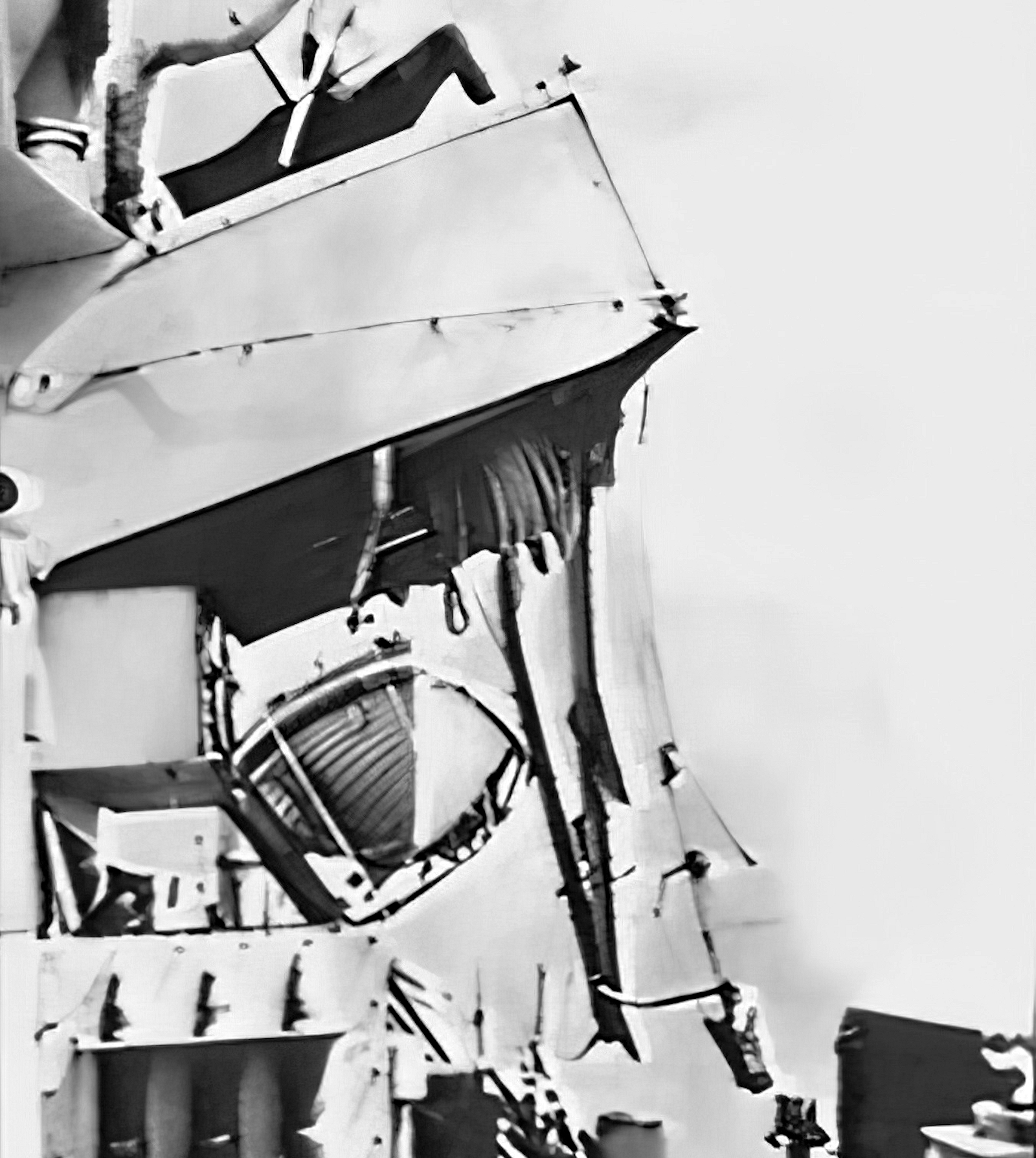
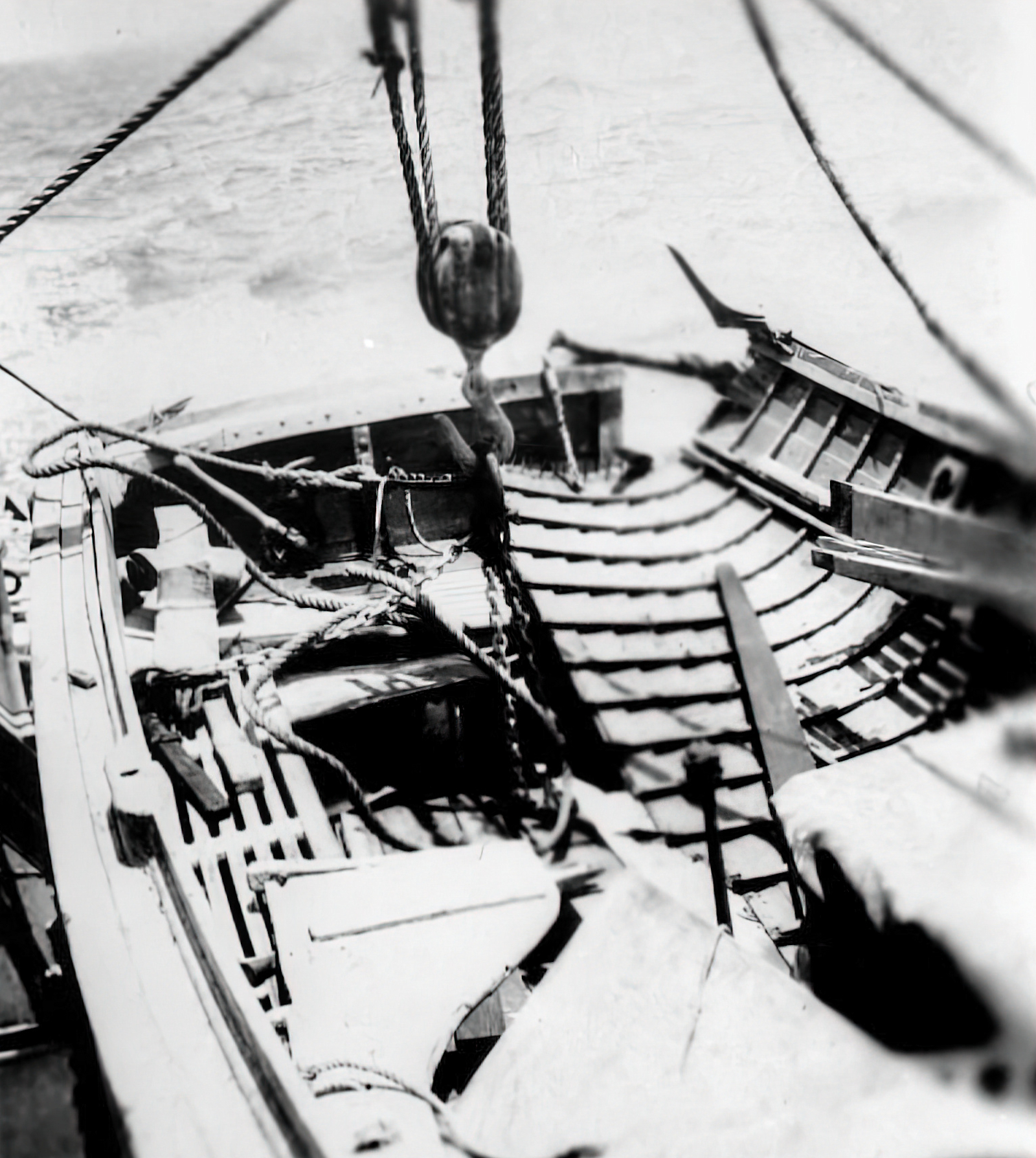
Left: Damaged port wing of the bridge and port motor boat and
stanchions after collision with HMS
SWIFTSURE off Okinawa. Right: Damaged to motor boat crushed in the same
collision.
Fuelling recommenced at 06:30 on the 5th, the weather conditions for fuelling having considerably improved. The Fleet disengaged from the Tanker Group, at 19:30 and set course at 20 knots for the operational area. Task Unit 112.2 .2 departed for Leyte. During this replenishment period SLINGER provided replacement aircraft and aircrews, she issued 22 represent aircraft to the fleet carriers and recovered 2 ‘flyable duds'. PIRIE and TAMWORTH escorted the Tankers ARNDALE and WAVE KING back to Leyte to reload.
At Leyte repairs were carried out by vessels of the Fleet Maintenance Group which was anchored in San Pedro Bay.
BPF and elements of the Fillet Train return to Australia to replenish
On completion of ICEBERG operations, the main part of the BPF was to carry out major replenishment in Australia. On May 27th the BPF became Task Force 37 (TF 37) when it transferred to the control of Admiral William Halsey's United States Third Fleet. TF37 arrived at Manus on May 30th and departed for Sydney the following day. The Fleet Train was also to withdraw from the base at Leyte; for the upcoming operations planned for July Manus was to be the base for the Fleet maintenance Group and the Fleet Train. Elements of TF 112 began withdrawing from mid-May, some to return to Australasia, others to Manus PIRIE remained at Leyte until May 13th when she dialled in company with IPSWICH to escort RFA BACCHUS o Manus. They arrived at Seeadler Harbour on May 21st after refuelling she sailed on the 22nd in company with LAUNCESTON to return to Sydney.
PIRIE proceeded to Brisbane where she underwent a self-maintenance period and stored ship in preparation for the return to Manus. On June 23rd Commander Travis left the ship, he was appointed Senior Officer22nd Minesweeping Flotilla and took over as commanding officer of HMAS GERALDTON. Lieutenant C.K .MacKenzie RANVR(S), PIRIE’s First Lieutenant was promoted to Lieutenant-Commander and appointed in command. PIRIE and element of the Flotilla sailed for Manus the same day.
Support for BPF operations against mainland Japan
PIRIE in company with BALLARAT, GERALDTON (Senior Officer) and WHYALLA arrived back at Manus on July 2nd to prepare for escort duties for replenishment Task Units for the next round of BPF operations.
After refuelling for the Tanker RAPIDOL she ailed from Manus on July 7th as part of the escort for TU 112.2.3 -Sloops CRANE, Frigate PARRETT, and Minesweepers
BALLARAT& PIRIE (RAN)
Tanker AASE MAERSK and CEDARDALE, and the Armament Store Issue Ship ROBERT MERSK. Because the operational area was now so far north, Leyte was no longer being used as the forward staging area, the replenishment carriers now had to return to Manus (2,300 miles south) for reloads and the tankers to Eniwetok in the Marshal Islands, 1,700 miles to the south east of the replenishment area, now codenamed ‘British Tizzy’. Some 300 miles southeast of Tokyo.
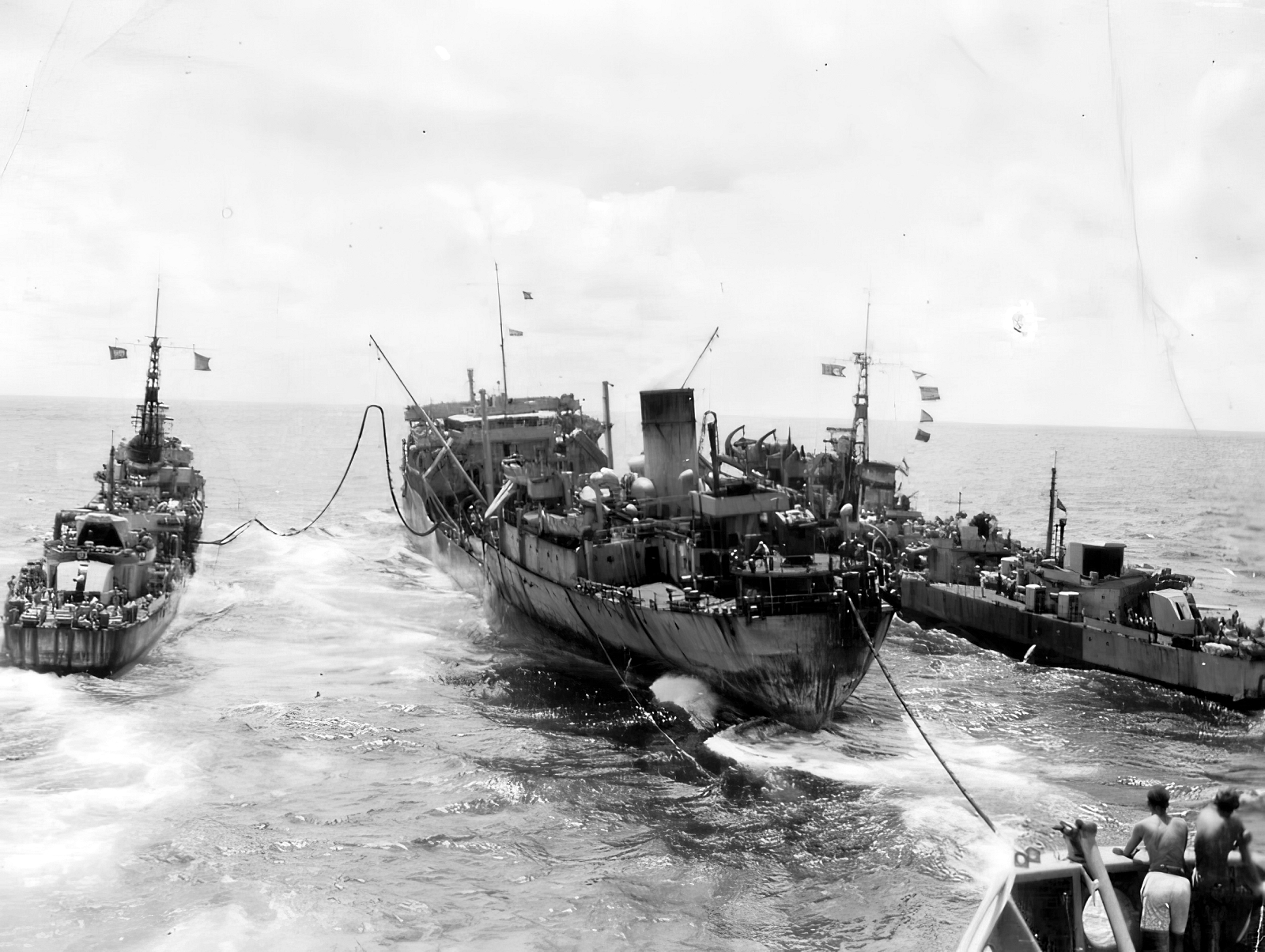
A Fleet Oiler refuels three vessels at the same time, a Destroyer to port and starboard by suspended hoses and the CVE RULER astern via a floating hose. HMAS PIRIE was assigned to escort several Tankers to and from the replenishment areas sometimes covering a voyage of over a thousand miles each way..
Escort for BPF replenishment at sea, July 26th – 27th
PIRIE and Task Unit 112.2.3, minus AASE MAERSK parted company on passage, destination ink own, joined the Logistic Support Group on July 25th. On station were TU 112.2.5, Sloops PHEASANT (Commander LSG), REDPOLE, and WHIMBREL without 112.2.12 the CVE RULER (885 Sqn), escorted by NEPAL (RAN). The replenishing force now comprised of TU 112.2.1 STRIKER (Replenishment) escorted by NAPIER (RAN), Tankers CEDARDALE and WAVE EMPEROR and TU 112.2. 3, the CVE SPEAKER (replenishment), escorted NORMAN (RAN), Tankers CARELIA, EASEDALE, and OLNA, Victualling Store Issue Ship GLENARTNEY, Armament Store Issuing Ships ROBERT MAERSK and CORINDA, escorted by light cruiser ARGONAUT, sloops CRANE, frigates ODZANI and DERG and minesweepers LAUNCESTON, PIRIE, WHYALLA (RAN).
TF 37 met with the LSG and Tanker Group in in replenishment ‘British Tizzy’ approximate position 28°4’ N 139°00’ E, on July 26th and oiling began at 09:00.Fuelling continued through the day and replacement aircraft and pilots were transferred to the carriers. The cruisers ACHILLES and NEWFOUNDLAND were detached to fuel from US TU 30.10.1. The fleet disengaged at 18:50 for the night.
Fuelling resumed at 05:15 on the 27th.
STRIKER transferred her remaining 3 replacement aircraft to
SPEAKER and dethatched for Guam on route to Manus. On completion of fuelling the tankers CEDARDALE and EASEDALE consolidated their reserves into CARELIA before detaching for Manus escorted by LAUNCESTON, WHYALLA. WAVE EMPEROR detached for Eniwetok to reload with PLYM and PARRET as escort. TF 37 and TF 38 set course overnight for the next morning’s flying off positrons. The LSG and Tanker Group also withdrew to reposition for the next planned replenishment.
Escort for BPF replenishment at sea, July 31 – August 2
TF 37 met with the LSG and Tanker Group, now comprising of OLNA, CARELIA, WAVE GOVERNOR and WAVE KING, in in replenishment ‘British Tizzy’ on July 31st and oiling began at 10:00. The replenishing force now comprised of the CVEs SPEAKER (Replenishment) and CHASER (Replenishment), GLENARTNEY, ROBERT MAERSK, CORINDA and ARBUTUS plus the four Tankers, escorted by destroyers NORMAN and QUEENBOROUGH, sloops CRANE, PHEASANT, WOODCOCK and REDPOLE, frigates ODZANI and DERG and minesweeper PIRIE. Fuelling continued through the day and replacement aircraft and pilots were transferred to the carriers. TF 37 disengaged at 18:50 for the night and changed course to the south to avoid the tail of a typhoon due to pass to their north.
Fuelling resumed at 05:20 on August 1st in approximate position 27° 15’ N 138° 00’ E. Oiling was hampered by a heavy swell and a typhoon still threatened the ships of TF 37 and TF 38; the US commander ordered a further move south at the end of the day’s replenishment, to rendezvous in area ‘HURRICANE’ at position 25° N, 137° E. On the morning of August 2nd storing and ammunitioning continued; oiling was now down to two tankers, two had to depart in order to reload and be back on station for the next replenishment period; WAVE
GOVERNOR transferred her fuel reserves into OLNA and CARELIA into WAVE KING. The LSG and the Tanker Group detached at 16:50 to proceed to the next replenishment area at 34° 20’ N, 147° E. At 17:00 CARELIA detached for Manus escorted by PIRRIE and ULYSES, and WAVE GOVERNOR detached for Eniwetok escorted by ODZANI.
Support for Task Group 38.5
By August 9th the US Third Fleet planned to attack targets in both northern Honshu on Hokkaido, the northern Island of Japan on August 10th; replenish on the 11th and conduct two more strike days on the 12th & 13th. This extension to the programme was problematic for the TF 37 which was due to withdraw for Australia after the strike on August 10th. The LSG and Tanker Groups were already executing the plans set out to prepare for the upcoming Operation OLYMPIC, the Invasion of Japan, so no Tanker support would be available. Also the US Logistic Group would not be able to contribute oil as it had done previously so the BPF would not be able to continue offensive operations in its present form. Vice-Admiral Sir Bernard Rawlings, 2 IC, BPF proposed a solution; a token force of 1 Battleship, 1 Fleet Carrier, 2 Cruisers and attendant Destroyers was to remain in the operational area for strikes against Japan with the US Third Fleet; this Force comprised of KING GEORGE V, INDEFATIGABLE, GAMBIA. NEWFOUNDLAND, TROUBRIDGE, TERMAGANT TENACIOUS, TEAZER, TERPSICHORE, BARFLEUR. NAPIER. NIZAM, WAKEFUL, AND WRANGLER. At 12:00 on August 12th Task Force 37 was dissolved and the bulk of the BPF set course for Manus, and then on to Sydney; the remaining Force were now attached to US Task Force 38 and designated as Task Group 38.5.
TG 38.5 was refuelled by the US Tanker Group on the 14th in Position 32° 11’ N 144° 33’ E as there would be no British Tankers available until August 18th as the Fleet Train scrambled to supply enough Tankers for the new planning.
CARELIA, PIRIE and ULYSSES arrived Manus on August 9th and the Tanker was reloaded and ready to sail again on the 11rth. PIRRIE was now joined by her sister ship CESSNOCK to escort CARELIA to 31°N 142 E° forming TU 112.2.28.
Japan surrenders
On the morning of August 15th PIRRIE was taking on fuel from CARELIA when she received the message “Japan has surrendered cease offensive action. Take all wartime precautions for self-defence”.
PIRIE and TU 112.2.28 joined the LSG and replenishment group on August 20th in position 32° 00’ N 14.3° 00’ E, replenishment area ‘British DRINK’. On station were the Tanker WAVE GOVERNOR CVEs RULER (CAP & ASP), SPEAKER (Replenishment), VSIS FORT WRANGLE, PHEASANT, ODZANI, RAN Corvettes IPSWICH and BALLARAT.
Replenishment had commenced on the 18th with three Tankers on station but SAN ADOLPHO, SAN AMBROSIO were detached at 17:00 on the 18th escorted by USK and BURNIE to reload. Refuelling continued on the 19th from WAVE GOVERNOR. Task Group 37.5had to disengage at dusk and relocate southwards due to a typhoon warning; the LSG did not follow but remained in the vicinity of ‘British DRINK’ to await further orders.
The LSG received orders to proceed to Tokyo Bay late in the afternoon of August 28th; at 05:40 on the 29th PIRIE was ordered to take on board all available provisions and went alongside the Naval Store Issuing Ship FORT WRANGELL receiving approximately two tons of fresh provisions before closing the tanker WAVE KING for two drums of lubricating oil transferred by Jack stay and sling. By 15:30 on August 30th the LSG was off the southern end of Honshu Island, about 540 miles southwest from Tokyo, when orders were received for entering Salami where allied vessels were to anchor in preparation for entering Tokyo Bay. At 07:00 on Friday August 31st the LSG entered Tokyo Bay; this now comprised of the tankers CARELIA, DINGLEDALE , and WAVE KING Store Issuing Ship FORT WRANGELL, CVE
RULER, Sloops CRANE, PHEASANT, WOODCOCK , Frigate DERG and the RAN Corvettes CESSNOCK, IPSWICH and PIRIE. PIRIE coming to anchor off Yokohama at 09:00. A t 09:30 hours on September 2nd 1945 the formal ceremony of surrender took place on board USS MISSOURI. The war had ended.
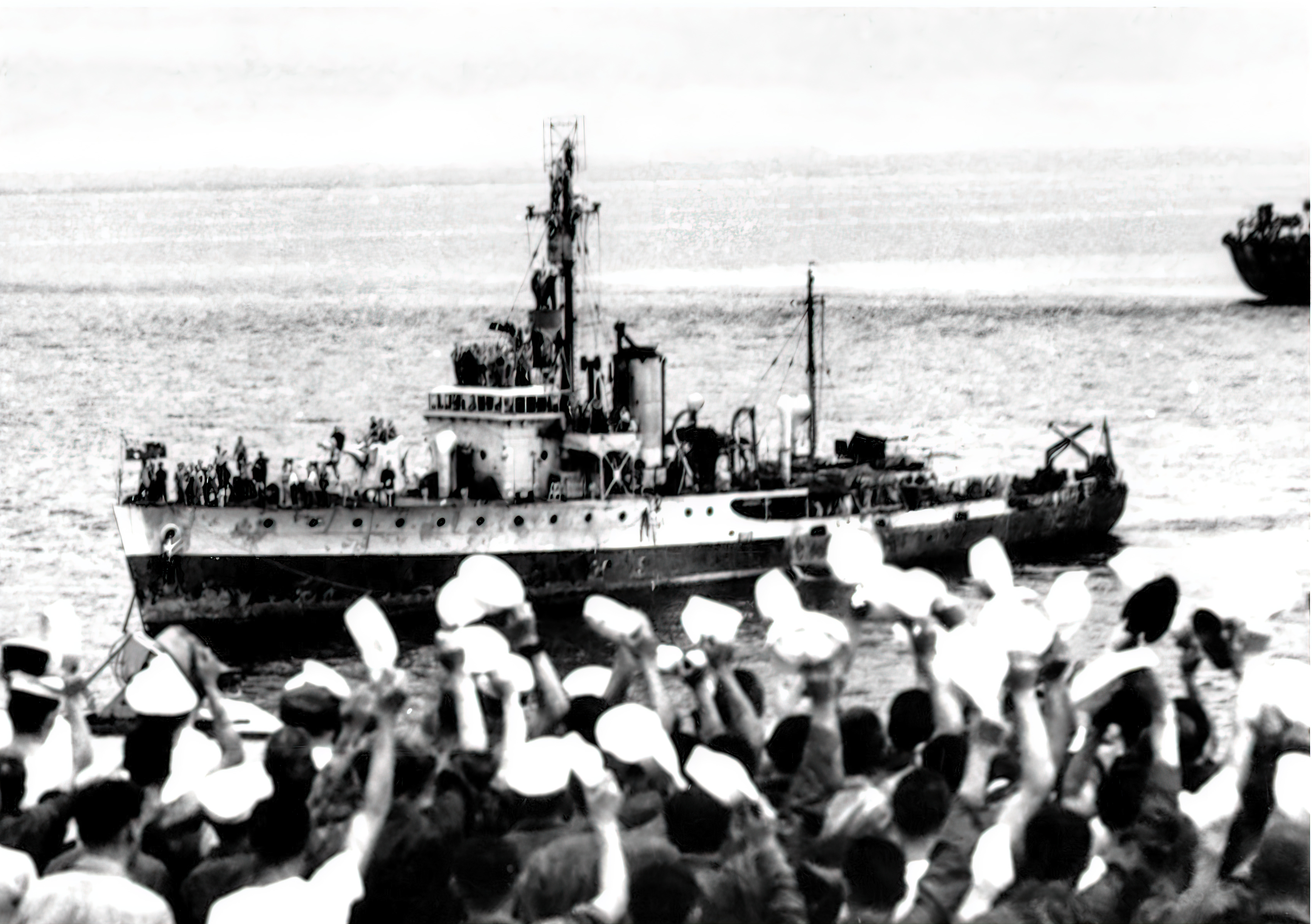
The CVE SPEAKER passes PIRIE as she made her way through the assembled ships of the allied fleet on her way out of Tokyo Bay, her ship's company and rescued POWs cheer and wave to each ship they pass.
Passage to Hong Kong
At 074:5 on September 5th PIRIE in company with the sloops PHEASANT, WHIMBREL, CRANE and WOODCOCK and Australian corvettes BALLARAT and CESSNOCK weighed and proceeded out of Tokyo Bay for passage Subic Bay in the Philippines. Four days out the weather started to deteriorate due to an approaching Typhoon. With seas rising and a huge Typhoon swell running the convoy was forced to alter course for Okinawa where they arrived at 09:22 on the 10th anchoring in Buckner Bay. PIRIE went alongside the Tanker WAVE KING to refuel. PIRIE had completed with fuel by 11:05 and moved to anchor off WAVE KING to wait for the remainder of the convoy to complete refuelling. The convoy steamed out to sea at 15:50 on the 10th for a second attempt to reach Subic Bay.
Subic Bay was reached at 12:15 on September 14th when PIRIE went alongside the fleet tanker OLNA for fuel before continuing on to the tanker SAN AMBROSIO for lubricating oil. The convoy departed Subic Bay at 16:20 and altered course for Hong Kong. Arrival at Hong Kong was made at 08:00 on the 17th when PIRIE anchored off the Typhoon Anchorage. The ship now commenced a long overdue Boiler Clean, her last one had been dome in Brisbane in Mid-June; this was completed on the 22nd. PIRIE and her sister RAN Corvettes were now allocated to conduct anti-piracy patrols at the entrance to Hong Kong harbour, local leave was granted for one watch per day when in harbour between patrols.
Return to Australia
On Thursday October 11th 1945 PIRIE in company with BROOME, CESSNOCK, GERALDTON, LAUNCESTON, STAWELL, WAGGA and WOLLONGONG weighed at 07:50 and sailed for Brisbane via Moratai and Thursday Island. The convoy reached Moratai at 1000 on October 17thand after refuelling sailed the next morning. Some of the convoy remained at Moratai, GERALDTON, LAUNCESTON, PIRIE, STAWELL and WAGGA sailed at 11:00 bound for Thursday Island, arriving there at 07:00 on the23rd. At 07:50 the following morning the small convoy sailed for Townsville. At 18:00 on the 26th PIRIE, WAGGA and STAWELL were detached to sail independently to Townsville, with PIRIE anchoring off the harbour entrance at 21:48.
PIRIE sailed for Brisbane on October 27th towing an Army motor launch, arriving on the Brisbane River on the 30th the launch was detached and PIRIE secured alongside the boom carrier HMS FERNMOOR at 18:00. The following morning PIRIE secured alongside the S.B.S.R. Wharf. She was to remain in Brisbane until December 18th when she sailed in company with her sister corvette WHYALLA at 09:00 en-route to Wallaroo, South Australia via Melbourne, PIRIE being Senior Officer. PIRIE was to pay a goodwill visit to her namesake town. Of Port Pirie.
Commissioned into the Royal Navy for transfer to the Turkish Navy
On Monday January 14th 1946 PIRIE received orders to sail direct to Sydney. Where she was to be decommissioned and transferred to the Royal Navy along with her sister corvettes GAWLER and LAUNCESTON. She secured to No.9 Buoy off Darling Point at 14:00 on January 18th. During her time with the RAN she had steamed a total of 117,230 miles at an average speed of 10 knots, with a total of 11,700 hours underway.
On April 5th 1946 HMAS PIRIE was decommissioned and recommissioned on the same date into the Royal Navy as HMS PIRIE. This was a temporary commission however as she was to be transferred to the Turkish Navy along with GAWLER and LAUNCESTON. The three corvettes departed from Sydney Harbour for the last time on May 21st 1946.
PIRIE arrived at Istanbul Harbour on August 11th 1946 and was recommissioned TCG AMASRA as a unit of the Turkish Navy. She was finally paid off on March 26th 1984 after forty-two years of service with three navies.
Last modified: 23 February 2023
Primary information sources
Additional sources:
Photo & history by John Lyall November 2009
Comments (0)